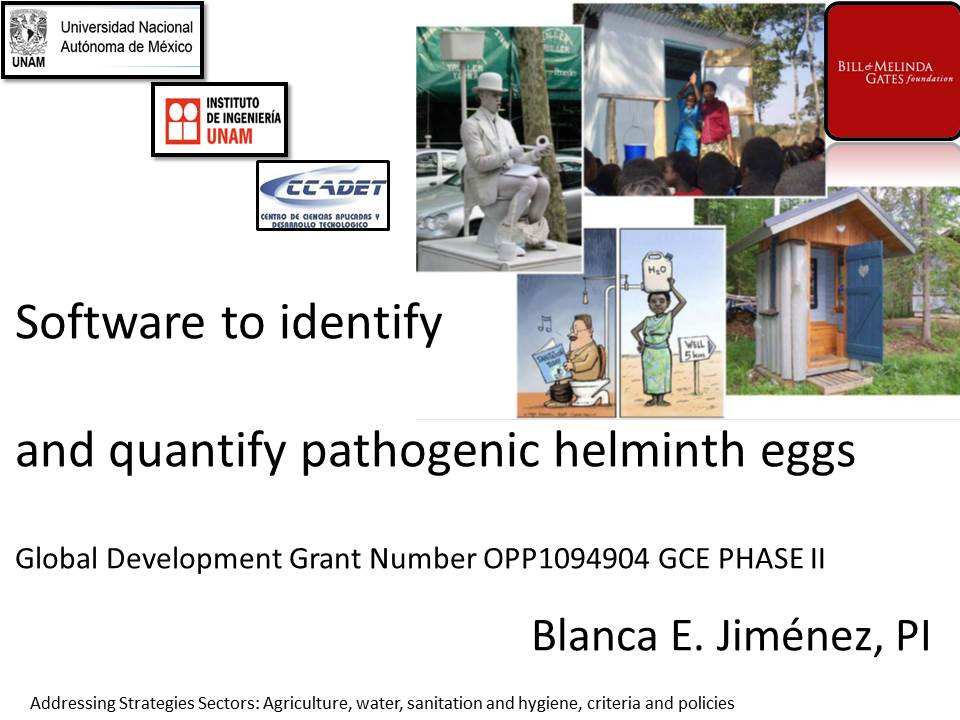Software to identify and quantify pathogenic helminth eggs - Various documents on results from research grant
Jiménez Cisneros, B. (2014)

Published in: 2014
Publisher:
Name of lead organization: Universidad Nacional Autónoma de México (UNAM), Mexico
Author:
Jiménez Cisneros, B.
Uploaded by:
SuSanA secretariat
Partner profile:
common upload
5278 Views
124 Downloads
Location of library entry
Content - Summary
This library entry contains background documents for a grant that Blanca Jiménez Cisneros is leading and which is funded by the Bill and Melinda Gates Foundation.
Further information and a discussion is available on the SuSanA discussion forum:
http://forum.susana.org/forum/categories/97-enabling-environment/2912-software-to-identify-and-quantify-pathogenic-helminth-eggs-university-universidad-nacional-autonoma-de-mexico-unam-mexico#9351
Short description of the project:
Name of lead organization: Universidad Nacional Autónoma de México (UNAM)
The following activities have been performed:
a) Integration of a library of helminth eggs images including eight different species, at three viability stages: viable eggs, non-viable eggs, and larval eggs.
b) Software development. Its functions involve detecting and labeling all visible objects in an image, using different processes (filtration, equalization, application of algorithms, etc.), and afterwards the classification of each detected objects based on shape (area, perimeter and eccentricity), and texture properties. The image library was needed to train the software on how a specific helminth egg would look like.
c) Software first validation. Comparative tests were conducted to determine the difference between software performance, and the results given by the standard identification and quantification technique performed by expert microbiologists. Most of the validation and software improvement have been done simultaneously.
The following activities are still ongoing:
a) To include additional helminth eggs species to the recognition protocol.
b) To finish the lab validation so all the objectives can be achieved.
c) To perform international peer-labs test and validation.
d) To develop a user friendly software that may be widely distributed.
e) To find a proper distribution channel that benefits target users (mostly) in developing countries.
Goal(s) Phase II:
To distribute this tool worldwide, and ensure mainly that those regions that have limited resources to perform wastewater, sludge, biosolids and excreta quality assessments have easy access to this tool.
Objectives (Phase II)
a) To increase the sensibility of the identification system when dealing with high solids content water (class III or raw wastewater) and establish the protocol for this case.
b) To validate the software to detect and quantify different genera of helminth eggs from samples of different water qualities including wastewater and greywater, and also from sludge, biosolids and excreta samples.
c) To include additional helminth eggs species to the recognition protocol.
d) To validate the system with international partners.
e) To test the system with Mexican partner labs which are certified in the standard technique to start local distribution.
f) To obtain a patent for the system.
g) To launch a worldwide distribution strategy.
h) To develop an easy-to-use platform of the software and the distribution strategy to reach the final users.
i) To test the last version and establish the distribution strategy.
Start and end date:
Phase I: 02/01/2012 to 06/01/2013
Phase II: 02/01/2014 to 01/01/2016
+++++++++++++++
The following documents are available for download below:
1 - Phase 1 Interim Report Number 1
2 - Phase 1 Interim Report Number 2
3 - Phase 1 Interim Report Number 3
4 - Phase 1 Interim Report Number 4
5 - Phase 1 Final Report (time period 2011 to 2013)
6 - Presentation: Software to identify and quantify pathogenic helminth eggs (April 2014)
7 - Updated presentation about the project (Sept. 2014)
Bibliographic information
Jiménez Cisneros, B. (2014). Software to identify and quantify pathogenic helminth eggs - Various documents on results from research grant. Name of lead organization: Universidad Nacional Autónoma de México (UNAM), Mexico
Filter tags
English Fundamental research and engineering Latin America & Caribbean















